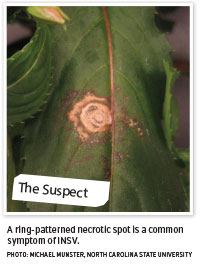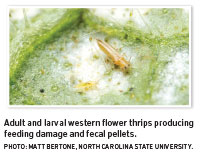reprinted with permission: Source: Greenhouse Management, October 2015, www.greenhousemag.com
INSV is incurable. Protect your plants with these savvy prevention tips.
- September 30, 2015
- Steven D. Frank
The breakdown
 Impatiens necrotic spot virus (INSV) is a constant threat to eggplant, lettuce, peppers, tomatoes and other greenhouse vegetable crops. This is because INSV is invisible, can spread before symptoms appear and is vectored by thrips, which are notoriously difficult to control. It is also impossible to cure. Therefore, INSV management has to start by monitoring plants and managing thrips.
Impatiens necrotic spot virus (INSV) is a constant threat to eggplant, lettuce, peppers, tomatoes and other greenhouse vegetable crops. This is because INSV is invisible, can spread before symptoms appear and is vectored by thrips, which are notoriously difficult to control. It is also impossible to cure. Therefore, INSV management has to start by monitoring plants and managing thrips.
You are probably familiar with Western flower thrips (Frankliniella occidentalis). They feed on hundreds of plant species including most vegetables, ornamentals and herbs. They also vector INSV. Western flower thrips can only acquire INSV by feeding on infected plants during their first larval stage. Once the thrips are infected, they can transmit the virus to other plants throughout their life.
Monitoring
Monitor for adult thrips with yellow sticky cards throughout the greenhouse. Also look for signs of thrips feeding. Thrips feed by scraping plant tissue then sucking the juices that are released. This leaves abraded patches of tissue that often become silvery. Thrips also leave small black fecal pellets at these feeding sites. When thrips feed on young leaves or meristems, the leaves become distorted because the damaged cells do not expand properly.
Inspect plants with these or other unusual symptoms
Many plants with INSV will eventually exhibit symptoms including ring-patterned spots, necrotic spots or streaking on leaves or fruit. Stems may have dark necrotic patches or wilt. However, symptoms may not show up for weeks or months after infection. Some plants never show symptoms. One of the most sinister aspects of INSV is that thrips can acquire the virus from asymptomatic plants and spread it throughout the greenhouse before you ever know it is there.
Warning signs
 Many growers use indicator plants to provide early warning that INSV is present. Indicator plants are plants that are particularly attractive and symptomatic to a particular pest or disease. For INSV, growers often use petunias, gloxinia, or fava beans as indicator plants, which typically show symptoms within a week. Spread a couple indicator plants throughout your greenhouse and inspect them frequently for INSV symptoms.
Many growers use indicator plants to provide early warning that INSV is present. Indicator plants are plants that are particularly attractive and symptomatic to a particular pest or disease. For INSV, growers often use petunias, gloxinia, or fava beans as indicator plants, which typically show symptoms within a week. Spread a couple indicator plants throughout your greenhouse and inspect them frequently for INSV symptoms.
Management
At the first sign of INSV, bag and discard the indicator plants so any thrips on them (which will likely be infected) do not move to crop plants. Then begin a zero-tolerance thrips management program because any thrips in the house could be infected. Thrips are only susceptible to insecticides as larvae and adults. Eggs are tucked safely within plant tissue and pupae are safe in the soil. Thus, even if you could make an insecticide application that would kill every larvae and adult thrips (you can’t), new larvae would hatch from eggs and new adults would emerge from pupae the next day. Therefore make at least three applications at five-day intervals to kill new larvae and adults, and break the population cycle. Monitor your crop and immediately bag and discard any plants with suspicious symptoms. Also set up new indicator plants to determine if infected thrips are still in the greenhouse.
Conclusion
Because plants cannot be cured of INSV and it is very hard to rid the disease from your greenhouse, prevention is key. Inspect new plants and cuttings for thrips or disease. Thrips often acquire INSV from weeds outdoors. Prevent thrips from entering your greenhouse with thrips screen and reduce movement of plants and people from outside to inside. Rid your greenhouse of weeds, pet plants, old stock plants and other non-essential plants, as these can be reservoirs for thrips and INSV.
INSV can be devastating if it becomes established in your greenhouse. But with constant monitoring, proper sanitation and effective thrips management, you can protect yourself from this threat.
Steven D. Frank is Associate Professor and Extension Specialist at North Carolina State University. He conducts extension and research related to greenhouse pest management.
http://www.greenhousemag.com/article/gm1015-INSV-plants-prevention-tips.aspx

Great job, very informative and nicely put into layman’s terms.